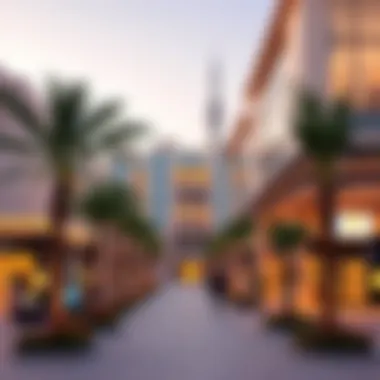Palm Strip Malls: Key Players in Dubai's Retail Scene


Intro
The real estate market in Dubai is like a desert oasis, constantly shifting to adapt to the needs and wants of a diverse population. One of the most interesting developments in this landscape is the emergence of palm strip malls. These unique venues combine retail space with an appealing social atmosphere, offering a one-stop shop for everything from groceries to fashion and eateries. Understanding the dynamics of palm strip malls is crucial for investors, developers, and even consumers who wish to navigate this vibrant segment of Dubai's retail scene.
As we delve into this article, we will explore various aspects of palm strip malls: their architectural configurations, the challenges they face, and the opportunities they present. By analyzing current trends and consumer behavior, we aim to provide a clear and comprehensive overview of why these establishments are not just functional spaces but pivotal components of community life.
Property Trends in Dubai
Emerging Neighborhoods and Hotspots
In recent years, Dubai has seen a surge in the development of new neighborhoods, each offering its unique flavor and potential. Areas such as Jumeirah Village Circle and Dubai Marina are witnessing a rapid transformation with the introduction of palm strip malls, which serve as hubs for social interaction and retail activity. Not only do these malls cater to the needs of residents, but they also attract tourists searching for that quintessential Dubai experience.
Some specific hotspots include:
- City Walk: With its open-air design and vibrant street life, City Walk is not just a shopping destination but a lifestyle precinct.
- The Beach at JBR: A favorite among both locals and tourists, this area combines leisure and shopping seamlessly, thanks to its beachfront location.
- Meydan One: Emerging as a significant player, Meydan One promises extensive shopping experiences alongside family-friendly activities.
Each of these neighborhoods showcases the adaptability of palm strip malls, proving their relevance in today’s rapidly changing Dubai landscape.
Market Analysis and Future Predictions
Understanding the market forces at play is crucial for anyone looking to invest in palm strip malls. Currently, the demand for retail space continues to grow alongside population increases and evolving consumer preferences. According to recent studies, over 60% of residents in Dubai prefer shopping in malls that offer both retail and communal experiences.
The boom in e-commerce has also prompted traditional retailers to enhance their physical presence, leading to a continual evolution of shopping spaces. Looking ahead, it’s anticipated that palm strip malls will increasingly feature:
- Mixed-use developments, integrating retail with residential and office spaces.
- More sustainable and eco-friendly designs that appeal to a growing awareness of environmental issues.
- Smart technology to facilitate shopping experiences, such as mobile payments and digital signage.
Such trends suggest a promising future for palm strip malls as essential destinations in Dubai's retail sector.
Investment Opportunities
High-ROI Property Types
For investors, identifying high-return property types is key. Palm strip malls have shown robust performance due to their versatility and utility. Properties located in prime areas tend to struggle less when it comes to vacancy rates. Furthermore, with the trend of mixed-use developments, potential investors can tap into multiple revenue streams. Key types include:
- Luxury retailers: High-end brands often seek flagship stores in prominent malls.
- Dining establishments: Restaurants and cafes frequently attract foot traffic, making them reliable investments.
- Service-oriented businesses: Salons, gyms, and wellness centers are also gaining traction in these malls.
Financing and Mortgage Options
Navigating financing for palm strip mall investments can be a complex but rewarding endeavor. Various mortgage options are available, including:
- Commercial mortgages: Specifically tailored for investors in retail properties.
- Syndicated loans: Enabling multiple lenders to provide funds for larger projects, spreading risk among investors.
- Asset-based lending: This type of financing is secured against the property itself, which can be a quicker option for those with existing assets.
Working closely with financial advisors or mortgage brokers who understand the Dubai market can provide invaluable insights for potential investors.
Understanding the trends and nuances of palm strip malls in Dubai can provide an edge, making the difference between a mediocre investment and a flourishing one.
As we wrap up this exploration of the palm strip mall sector, the collective insights reveal that navigating this space requires not just knowledge but also a keen eye for innovation and community needs. In an ever-evolving market like Dubai's, staying informed is the best recipe for success.
Prelims to Palm Strip Malls
As Dubai continues to emerge as a vibrant hub for tourism and business, the relevance of palm strip malls has soared within its real estate landscape. These unique shopping venues not only cater to the burgeoning consumer market but also reflect the city's distinct architectural and cultural essence. In this article, we delve into the components that make palm strip malls significant in Dubai, focusing on aspects such as their design, economic contribution, and potential growth.
Defining Palm Strip Malls
Palm strip malls are essentially open-air shopping centers lined with palm trees and situated along main thoroughfares. These establishments provide a novel shopping experience by blending retail offerings with an outdoor environment, allowing patrons to stroll amidst greenery while enjoying a diverse selection of shops and eateries. The term 'palm strip' itself evokes images of relaxation, leisure, and urban living, making these malls a favorite among both locals and visitors.
The features of palm strip malls include:
- Convenience: Typically located in residential or commercial areas, they are easily accessible, often with ample parking.
- Eclectic Mix of Retail: They house a variety of storefronts, ranging from boutique shops to restaurants, ensuring there’s something available for everyone.
- Community Focus: These malls often host events and social gatherings, enhancing community engagement and creating a sense of belonging among visitors.
Historical Context of Palm Strip Malls
The concept of palm strip malls emerged as a response to both the evolving lifestyle of Dubai residents and the growing demand for unique shopping experiences. Traditionally, shopping in Dubai revolved around large enclosed malls. However, with a shift towards outdoor-centric lifestyle choices, especially in the cooler months, there emerged a space for palm strip malls.
The historical development can be traced back to the early 2000s, when urban planning began to prioritize mixed-use environments, incorporating residential, commercial, and recreational spaces. The allure of a more relaxed shopping experience led developers to create malls that prioritize design and landscaping. Factors such as the local climate—prime for outdoor activities— and the cultural embrace of social spaces played critical roles in their inception and evolution.
In summary, palm strip malls are more than just places to shop; they serve as social hubs that mirror the cultural and economic growth of Dubai. They integrate the city’s architectural aesthetics with the conveniences of modern retail, highlighting the need for such unique offerings in an increasingly competitive real estate market. Understanding this setting is essential for investors and stakeholders aiming to navigate the evolving landscape of Dubai's retail sector.
Significance of Palm Strip Malls in Dubai
Palm strip malls hold a pivotal role in the tapestry of Dubai's retail landscape, evolving to meet the changing dynamics of consumer habits and urban development. Their significance extends beyond mere shopping spaces; they are becoming vital community hubs that enhance social interactions and economic vitality. These malls provide a unique blend of convenience and lifestyle, effectively catering to the diverse population of Dubai.
Economic Contributions
The economic impact of palm strip malls in Dubai cannot be overstated. They contribute significantly to the local economy by generating job opportunities across various sectors, from retail to hospitality. These malls ensure that local businesses thrive, with many small and medium enterprises finding their footing among the more prominent brands. Not only do they contribute to employment, but they also foster competition, which often leads to better quality goods and services for consumers.
Moreover, palm strip malls elevate real estate values in their vicinity. As more people flock to these areas for shopping and dining, the demand for nearby residential and commercial properties increases, creating a ripple effect that boosts overall economic activity. This correlation is something that investors and developers keenly observe. They recognize that a well-located palm strip mall can enhance the attractiveness of a neighborhood, leading to increased foot traffic and potential revenue.
"Investors are increasingly seeing palm strip malls as a sound investment, with return rates that often outperform more traditional retail spaces."
Another notable economic contribution is the tax revenues generated by these establishments, which help fund community services and infrastructure. For instance, the sale taxes collected can be reinvested into local amenities, benefiting both businesses and residents alike.
Cultural Relevance
Beyond economics, palm strip malls reflect the cultural melting pot that is Dubai. They serve as vital spaces where the rich tapestry of Emirati and expatriate lives converge. People from various backgrounds come together, creating a unique atmosphere that promotes shared experiences and cultural exchange.
These malls often host events that celebrate significant cultural festivals, art exhibitions, and community gatherings, making them central to social engagement in Dubai. For example, during Ramadan, many palm strip malls hold iftar events or special sales, inviting community members to participate and enjoy the evening together. Such initiatives not only foster community spirit but also enhance the cultural fabric of Dubai.
The architectural designs of these malls often incorporate elements that resonate with local traditions, blending modern innovation with cultural heritage. This thoughtful merging of aesthetics and functionality attracts not only residents but also tourists, adding to the overall cultural tourism landscape of Dubai. Overall, the cultural relevance of palm strip malls should not be overlooked; they are much more than retail spaces; they are reflections of Dubai's identity and a testament to its diverse population.
Architectural Features of Palm Strip Malls
The architectural intricacies of palm strip malls play a pivotal role in defining not only their aesthetic appeal but also their functionality within Dubai’s rapidly evolving retail landscape. These structures reflect a unique blend of modern design and cultural elements, which cater specifically to the needs and expectations of the consumer populace. The layout, materials, and overall design concepts used in palm strip malls are tailored to maximize both foot traffic and the shopping experience.
Design Concepts
Design is far more than skin deep; it molds the shopping experience and influences consumer behavior. Palm strip malls often embrace an open-air format, which encourages strolls that meander through vibrant storefronts and inviting landscaping. This outdoor design not only capitalizes on the pleasant climates of Dubai but also fosters a sense of community connection.
Several essential elements constitute the design of these malls:


- Use of Natural Light: Large glass facades or skylights allow sunlight to pour into the retail spaces, making the interiors more inviting.
- Sustainability Initiatives: Incorporating green technologies, such as solar panels for energy and rainwater harvesting systems, aligns with global trends towards environmental consciousness.
- Flexible Layouts: Many malls employ adaptable spaces designed to accommodate seasonal events or pop-up shops, adding a layer of dynamism to the retail experience.
Importantly, the aesthetic choices should resonate with the local culture and heritage. By integrating traditional architectural motifs alongside contemporary design, developers can create spaces that honor the region, garnering community buy-in and interest.
Integration with Surrounding Environments
A palm strip mall's success is often tied to how well it harmonizes with the surrounding area. Good architecture is characterized not just by its buildings, but by its urban contexts. Integrating these malls within the existing urban landscape is crucial for attracting both residents and tourists alike.
There are several ways in which palm strip malls can achieve this:
- Creating Green Spaces: Landscaping that incorporates local flora not only beautifies the environment but also promotes biodiversity and sustainability.
- Accessibility Considerations: Thoughtful placement near public transportation routes or major thoroughfares ensures that the malls are accessible to a larger audience.
- Cultural Features: Including public art installations or community gathering spaces can uplift the overall ambiance, fostering a feeling of belonging among visitors.
The architectural features of palm strip malls are vital in creating a vibrant nexus for economic activity, social interaction, and community pride.
In summary, when these malls are thoughtfully designed and integrated into their environments, they do not merely serve as places to shop; they become focal points for community engagement, enhancing the quality of life for both residents and visitors in Dubai.
Types of Retail Offerings
Understanding the types of retail offerings present in palm strip malls is essential for anyone looking to navigate the vibrant landscape of Dubai's real estate market. These malls cater to diverse consumer needs, blending convenience with variety. This focus not only enhances customer experience but also ensures a steady stream of foot traffic, which is crucial for business viability.
Convenience Stores and Grocery Outlets
Convenience stores and grocery outlets play a pivotal role in palm strip malls, often acting as the anchors of these retail centers. Malls that include these establishments benefit from an immediate consumer base, where local residents can easily access essential goods without needing a lengthy trek. These outlets tend to be designed for quick visits, allowing shoppers to pick up daily necessities efficiently.
The presence of well-known grocery chains like Carrefour or smaller local brands like Al-Faheem Grocery creates an environment that encourages habitual shopping. Customers tend to favor locations where they can fulfill their shopping needs in one convenient stop. Moreover, the adaptability of these stores to offer organic and specialty items can attract a range of demographic groups looking for particular products.
Restaurants and Cafés
Restaurants and cafés sprinkle a unique charm into the mix of palm strip malls. They serve not just as dining options but as community gathering spots. The culinary offerings can range from casual eateries to more upscale dining experiences, catering to a variety of tastes.
For instance, an establishment like Shake Shack can appeal to families while local favorites like Bu Qtair attract a more eclectic crowd looking for authentic Emirati cuisine. Offering outdoor seating is also a savvy way to enhance the customer experience, especially given Dubai's favorable weather for much of the year.
Moreover, in this age where social media plays a vital role, having visually appealing dining spaces can help restaurants thrive. Instagrammable dishes and environments can generate free advertising through social shares, a win-win for business owners.
Specialty Shops
Specialty shops further enrich the retail environment, providing unique shopping experiences that larger corporate stores often cannot match. These outlets can range from artisanal bakeries to handcrafted jewelry stores, fulfilling niche markets. Having a few of these in a palm strip mall can distinguish it from competitors and draw in a broader customer base.
For example, a store like The Paper Paper Co. provides bespoke stationery that attracts not only locals but tourists looking for authentic souvenirs. Similarly, a local art gallery can host exhibitions that engage the community and draw in visitors. These specializations not only allow for varied shopping experiences but also foster community identity and local culture.
It's clear that diverse retail spaces within palm strip malls serve critical functions in attracting foot traffic, fostering community, and providing convenience.
For more insights on retail trends, consider checking resources like Council of Retail and Shopping Centers or engaging with community discussions on platforms such as Reddit.
Further reading:
- Understanding Retail in Dubai
- The Evolution of Convenience Stores
- Impact of Specialty Shops on Local Economy
Investment Opportunities
Palm strip malls in Dubai present a compelling opportunity for both seasoned investors and newcomers to the market. Understanding investment opportunities tied to these retail spaces requires a keen focus on several elements. Investors should look beyond the immediate returns and consider long-term potential as well as market dynamics.
The primary allure of investing in palm strip malls lies in their strategic locations. These malls are typically situated in high-traffic areas surrounded by residential neighborhoods, catering to the daily needs of the local population. This positioning ensures a consistent flow of foot traffic, which can translate into steady sales for tenants. The increasing population in Dubai bolsters demand for accessible retail options, making this an attractive sector.
Additionally, the diversity of retail offerings within these palm strip malls can be highly beneficial. Unlike traditional shopping experiences, palm strip malls often feature a mix of convenience stores, specialty shops, dining options, and cafes. This variety can not only enhance the customer experience but also mitigate risks for investors by diversifying revenue streams. Investors should pay close attention to the types of businesses that occupy these spaces, favoring longstanding brands or those with proven concepts that promise stability.
Market Trends
When diving into the market trends associated with palm strip malls, it is important to recognize their adaptive nature within the real estate landscape. Recent years have seen a rise in consumer preferences leaning towards local shopping experiences, as many residents favor unique local retailers over chain stores. This trend reinforces the role of palm strip malls as community-focused hubs, providing opportunities for small businesses.
The influx of digital commerce cannot be overlooked, either. While it poses a challenge to brick-and-mortar retailers, palm strip malls have adapted by integrating omnichannel strategies. For instance, many stores now offer online ordering alongside physical inventory, allowing for a seamless shopping experience that caters to the modern consumer.
Moreover, sustainability initiatives have captured the interest of forward-thinking investors. Many new projects in the Dubai area are aiming to meet green building standards, enhancing their appeal to socially-conscious investors and tenants alike. Thus, awareness of sustainable practices can be a factor to consider in evaluating investment opportunities in this niche.
Evaluating Returns on Investment
Evaluating returns on investment in palm strip malls involves a nuanced approach, one that balances performance metrics with qualitative factors. Investors should begin by analyzing the rental yields, which remain relatively healthy when compared to other types of commercial real estate across Dubai. The average returns in some areas have been reported to hover around 10% to 12%, but this can fluctuate based on location, tenant mix, and overall mall management.
To perform thorough evaluations, consider employing some of the following strategies:
- Conduct Market Research: Understand local demand by studying demographic trends, income levels, and regional economic growth. This can provide insight into potential profitability.
- Analyze Comparable Properties: Comparing palm strip malls to similar retail properties can yield vital data on occupancy rates and rental trends.
- Financial Performance Metrics: Dissect financial statements of existing malls to glean insights into operational costs, tenant turnover rates, and overall profitability.
Investors must also remain vigilant of potential external factors. Economic shifts, regulatory changes, and trends in consumer behavior can radically impact ROI. Staying informed through resources such as local real estate reports or market analyses from credible institutions (e.g., en.wikipedia.org) will be invaluable in making sound investment decisions.
Challenges Faced by Palm Strip Malls
In the ever-evolving landscape of Dubai's retail real estate, palm strip malls find themselves at a crossroads. While these venues have managed to carve out a niche, they face a whirlwind of challenges that demand attention from investors and developers. Understanding these obstacles is crucial for stakeholders looking to thrive in this competitive environment.
Competition from Online Retail
The rise of e-commerce has been nothing short of a revolution. As online shopping becomes the norm, traditional retail outlets, including palm strip malls, feel the squeeze. Customers enjoy the convenience of shopping from their sofas, often finding better deals and a vast array of products online. As a result, foot traffic in physical stores declines, compelling businesses to rethink their strategies.
Here are some insights regarding this shift:
- Consumer Shift: Many consumers now prefer the ease of online shopping, leading to significant competition. Palm strip malls need to adapt by creating unique in-store experiences.
- Enhanced Online Presence: Retailers within palm strip malls must establish a strong online presence. This includes offering promotions that entice shoppers to visit in person, combining both platforms to harness sales potential.
- Customer Experience: Physical stores must focus on customer engagement—creating atmospheres that online retailers cannot replicate. This can mean hosting community events or offering personalized services.
"With e-commerce expanding like wildfire, brick-and-mortar stores must adapt or risk fading into obscurity."
Economic Fluctuations
Economic conditions play a pivotal role in shaping the retail landscape in Dubai. Fluctuations in the market can directly impact the viability of palm strip malls. Factors such as changes in consumer spending, shifts in the job market, and fluctuating interest rates can create an unstable environment that’s tough to navigate.
Key considerations include:
- Consumer Confidence: During downturns, consumers tighten their belts, leading to reduced spending in retail outlets. This particularly affects non-essential items, which often constitute a large portion of sales in palm strip malls.
- Investment Risks: Investors must weigh the potential risks posed by economic uncertainty. With local markets being unpredictable, thorough assessment and due diligence are essential to choose the right time and avenue for investment.
- Loan Availability: Economic conditions often affect lending, which in turn can limit developers' and businesses' abilities to secure financing. Restrictions on loans can lead to halted projects or reduced renovations, diminishing the ability of malls to stay competitive and modern.
Consumer Behavior Trends
Understanding consumer behavior is crucial when evaluating the role and future of palm strip malls in Dubai's real estate landscape. The trends reflect how shoppers have changed their preferences and habits, which directly impacts the operations and offerings of these retail spaces. To make informed decisions, stakeholders—be it investors, property developers, or business owners—must delve into these trends, for they hold the keys to success in a competitive market.


Shifting Preferences
Over the years, the preferences of consumers have undergone notable transformations, particularly in urban settings like Dubai. Gone are the days when shopping was solely about acquiring products. Today's consumers seek experiences. This shift can be seen in the rise of lifestyle malls that offer more than just retail spaces; they provide an environment where leisure, cuisine, and community interaction thrive.
For instance, many shoppers now favor eco-friendly options and local artisanal goods over mass-produced items. An emerging group of consumers is gravitating towards organic grocery stores, artisan markets, and boutiques that offer handcrafted products. This demand forces palm strip malls to adapt accordingly. Malls such as The Pavilion or The Diamond have embraced this change by featuring farmers' markets or pop-up shops, creating an attractive mix of offerings that appeal to conscientious buyers.
Moreover, the advent of social media has played a pivotal role in shaping these preferences. Shoppers are not only influenced by advertisements but also by online reviews and experiences shared by peers. As a result, malls have started integrating social media strategy into their marketing.
- Community Events: Organizing local events fosters a sense of belonging, encouraging foot traffic.
- Social Media Engagement: Featuring brand partners or special promotions on platforms like Instagram or Facebook draws attention.
Expectations from Retail Environments
As consumer preferences shift, so do their expectations for retail environments. There's a growing demand for convenience and accessibility. Modern consumers are looking for seamless experiences from the moment they enter the premises. A key aspect is the advent of omnichannel retailing, where customers expect to transition fluidly between online and offline shopping. This expectation presents unique challenges and opportunities for palm strip malls in Dubai.
To keep pace, these malls must ensure a well-designed layout and user-friendly navigation. Elements such as adequate signage, relaxing seating areas, and technological integration play critical roles in enhancing shopper experience. Features like free Wi-Fi and mobile charging stations are no longer perks; they are expected amenities.
Furthermore, safety and hygiene concerns have gained prominence, particularly post-pandemic. Consumers are increasingly cautious about cleanliness and physical distancing measures. Palm strip malls need to prioritize maintaining clean surfaces and providing hand sanitizers throughout their spaces.
"The modern consumer is like a finely tuned instrument. If you don't play the right notes, they'll simply walk away."
For further insights and detailed information regarding retail trends, interested parties can explore:
- Wikipedia: Consumer Behavior
- Christian Science Monitor: Pandemic Retail Trends
- McKinsey & Company: Consumer Insights
By paying close attention to these emerging consumer behavior trends, stakeholders in the palm strip mall market can better position themselves to meet the expectations of today's discerning shoppers.
Regulatory Framework
The landscape of palm strip malls in Dubai's real estate sector does not exist in a vacuum. Instead, it dances within a regulatory framework that shapes everything from the ground up to the storefront. This framework is essential, as it dictates what developers can build, where they can build it, and how the establishments must operate. Understanding these regulations isn’t just a box to tick; it’s a crucial part of strategic planning for anyone looking to dive into this niche market.
Permitting and Compliance
Navigating the maze of permitting and compliance can feel like trying to find one's way through a desert without a map. The initial step for any developer interested in establishing a palm strip mall is securing the appropriate permits. These permits serve as a green light, signaling that a project aligns with local zoning laws and land use policies.
Before even breaking ground, developers ought to consider the following:
- Zoning Regulations: These define what types of businesses can operate in a given area. For instance, certain zones might restrict food establishments or limit the types of services offered.
- Building Codes: Compliance with safety, accessibility, and environmental standards is non-negotiable. Not adhering to these can lead to costly revisions or even project shutdowns.
- Environmental Considerations: Projects are often scrutinized for their impact on local ecosystems. Factors like water retention, waste management, and energy consumption are critically assessed.
- Community Engagement: In some cases, authorities may require developers to hold community consultations to gauge public opinion on the proposed projects.
Obtaining these permits may involve extensive documentation and may lead to unforeseen delays, making thorough preparation vital.
Impact of Regulations on Development
The regulatory landscape profoundly affects the development of palm strip malls. It acts both as a guideline and a barrier—smoothening the path for compliant projects while also imposing limitations that can cause frustrations.
For instance, regulations shape the design and structure of the palm strip malls:
- Architectural Limitations: Height restrictions and aesthetic guidelines ensure that new structures maintain the city’s unique skyline and cultural identity. This can lead to innovative design solutions that enhance rather than detract from the neighborhood character.
- Market Entry Requirements: Certain compliance measures can deter less experienced investors who may lack the resources to navigate complex regulations. As a result, only seasoned developers often engage in this segment, leading to a homogenization of offerings.
- Economic Incentives: On the upside, the framework can also provide incentives for sustainable practices. For instance, developers may receive tax breaks for adopting green technologies or for minimizing their ecological footprint, promoting a long-term vision for urban development.
In summary, engaging with the regulatory framework is an essential endeavor for anyone looking to invest in or develop palm strip malls in Dubai. It not only affirms the legitimacy of a project but also defines its viability in the competitive market. Understanding these guidelines can save time, money, and, ultimately, a lot of headaches.
Sustainability Practices
Sustainability has become a crucial focus in today’s real estate landscape, particularly within the realm of palm strip malls in Dubai. As shopping centers evolve, incorporating sustainable practices is not just a trend but a necessity. These eco-conscious initiatives not only attract environmentally aware consumers but also enhance the long-term viability of the malls, making them more appealing to investors.
Eco-Friendly Construction Methods
When constructing palm strip malls, eco-friendly construction methods play a vital role. Materials that are sourced sustainably and environmentally friendly are significant. Using recycled steel, for instance, can dramatically reduce carbon footprints. Another interesting approach is the implementation of energy-efficient building techniques such as passive solar designs or green roofing, which can help reduce energy consumption. Furthermore, opting for local materials not only cuts down transportation emissions but also supports the local economy.
Some notable eco-friendly practices might include the use of:
- LED lighting: They consume less power and have a longer lifespan than conventional bulbs.
- Water-efficient fixtures: Saving water is crucial in desert environments like Dubai.
- Renewable energy sources: Utilizing solar panels can provide a sustainable energy source, helping malls to be more self-sufficient.
These methods not only contribute positively to the environment but also appeal to a growing demographic that prioritizes sustainability when making purchasing decisions.
Sustainable Retail Initiatives
Beyond construction, sustainable retail initiatives within palm strip malls can create an atmosphere of responsibility and community engagement. Encouraging retailers to adopt green practices can have a ripple effect, transforming shopping habits. Retailers could focus on:
- Local sourcing: By supporting local producers, stores can minimize transportation-related emissions and support the local economy.
- Reducing plastic use: Offering alternatives to single-use plastics, such as reusable bags or containers, can significantly lower waste generation.
- Waste management programs: Initiatives that educate consumers on recycling and waste disposal can foster a culture of sustainability among shoppers.
Engagement with the community can further enhance these initiatives. Collaborating with local organizations to promote sustainability-focused events can increase visibility and consumer interest.
It is no longer enough to just offer products; businesses are increasingly expected to operate in environmentally friendly ways.
By integrating sustainable practices into both construction methods and retail strategies, palm strip malls can pave the way for a greener future. This not only aligns with global trends but also contributes to the social responsibility that consumers expect today.
Future Trends
The realm of palm strip malls in Dubai is not just about the present; it’s a crystal ball moment to glimpse into the future. Understanding future trends is crucial for investors, retailers, and urban planners. This section dives into pivotal elements that are shaping the future of palm strip malls, alongside their benefits and considerations.
Technological Innovations
In a fast-paced world, technological advancements are interwoven with consumer expectations. Palm strip malls stand to benefit from incorporating various technologies that enhance operational efficiency and customer experience. Key innovations include:
- Smart Parking Solutions: With the increase in foot traffic, finding parking can be a headache. Smart systems that guide visitors to available parking spots can streamline the experience greatly.
- Contactless Payments: The rush towards digital payment methods, accelerated by the pandemic, has made contactless payments a norm. Shops with seamless checkout processes are favored, making technology a bigger player in consumer retention.
- Augmented Reality (AR): Shoppers appreciate unique experiences. Integrating AR in malls can allow customers to view product details or navigate stores using their smartphones, making shopping interactive.
- Inventory Management Systems: Advanced systems can help retailers track stock levels in real-time, reducing the issue of empty shelves and ensuring customer satisfaction.
These technologies not only bolster operational management but also create a more enjoyable shopping experience, driving footfall and encouraging sales.
Pandemic-Driven Changes
The COVID-19 pandemic reshaped retail landscapes globally, including palm strip malls in Dubai. Understanding these shifts is essential for adapting to an evolving market. Some critical changes prompted by the pandemic include:
- Health Protocols: Enhanced sanitization measures, such as regular cleaning and air filtration systems, are now commonplace. Shoppers are increasingly concerned about hygiene, and these steps can reassure customers.
- Flexible Business Models: Malls that offer versatile leasing arrangements are more likely to attract a variety of businesses. This flexibility can lead to a more dynamic atmosphere, accommodating changes in consumer behavior.
- Emphasis on Outdoor Spaces: With social distancing becoming the norm, outdoor dining and shopping areas have gained popularity. Malls that incorporate outdoor environments not only comply with safety measures but also enhance the overall shopping experience.
- Focus on Sustainability: A rising awareness around environmental issues means consumers are gravitating towards businesses that prioritize sustainable practices. Malls promoting eco-friendly initiatives can find a dedicated customer base looking for responsible shopping options.
According to a recent study from Harvard Business Review, the combination of health safety and sustainability will likely dictate a new norm in consumer engagement. As a result, palm strip malls that adapt to these pandemic-driven changes may thrive while others fall behind.
‘The adaptability of palm strip malls is vital for their survival and growth in a post-pandemic world.’
Case Studies


The analysis of case studies in this article is pivotal, as it gives us practical insights into the real-world operations of palm strip malls in Dubai. By examining specific instances, we can glean lessons on what strategies have succeeded and where others may have fallen short. Case studies serve as a roadmap, illuminating the nuances of managing these retail spaces effectively in the unique market dynamics of Dubai. They provide context that theoretical knowledge alone cannot, helping investors and stakeholders make informed decisions.
Successful Palm Strip Malls
In recent years, several palm strip malls in Dubai have outshone their counterparts, standing out due to strategic location, tenant diversity, and consumer engagement. One such example is the Al Furjan Pavillion. This mall showcases a vibrant mix of retail outlets, restaurants, and community spaces, effectively catering to the diverse demographics of the surrounding neighborhoods.
- Strategic Location: Situated adjacent to major residential areas, it draws in foot traffic from local residents. This accessibility plays a significant role in its success.
- Tenant Mix: The blend of high-end retail, unique local boutiques, and traditional dining options resonates well with both tourists and residents, providing a comprehensive shopping experience.
- Community Engagement: Regular events, such as weekend markets and cultural festivals, make it a hub for community gatherings. This fosters customer loyalty and continuously attracts new visitors.
Another remarkable case is The Springs Souk, which emphasizes sustainability and a family-friendly atmosphere. With its lush landscaping and open-air design, this mall doesn't just sell products; it sells a lifestyle. Here’s how:
- Sustainability Initiatives: It includes green spaces and eco-friendly infrastructure, appealing to the environmentally-conscious consumer.
- Family-Centric Features: Play areas for children and quiet zones for parents help solidify its reputation as a family-friendly destination.
These examples illustrate that successful palm strip malls combine strategic location choices, tenant diversity, and community engagement to thrive in Dubai's competitive landscape.
Lessons from Underperforming Projects
Not every palm strip mall shines as brightly as the successful cases. Some projects struggled, offering invaluable lessons for future endeavors. For instance, Jumeirah Village Mall faced significant challenges due to its isolated location and lack of a robust public transport system.
- Accessibility Issues: The mall's placement away from major thoroughfares led to limited visibility and poor foot traffic, which is crucial for retail success.
- Inadequate Market Research: A mismatch between the tenant mix and local demand resulted in unoccupied retail spaces. Many boutiques and services offered did not align with consumer preferences, leading to the mall's gradual decline.
Another cautionary tale could be Dubai Outlet Mall, which in its early stages experienced considerable underperformance. It serves as a reminder of the importance of:
- Understanding Consumer Behavior: Initial marketing strategies failed to resonate with the target demographic, illustrating the necessity of aligning offerings with customer desires.
- Flexibility in Operation: As market conditions shift, belonging to a broad retail concept or having the capability to pivot is essential. This specific mall has made strides in recent years by introducing new brands and hosting events to rejuvenate interest.
These underperforming examples underscore the importance of location, market research, and adaptability in developing successful retail spaces. They highlight that understanding customer needs and being aware of operational context are as crucial as having a solid financial backing.
"Every setback may just be a setup for a comeback. Learning from past missteps is invaluable for paving the way forward."
Through these case studies, both successful and underperforming, stakeholders can better navigate the complexities of the Dubai palm strip mall market, leading to more informed investment choices moving forward.
Community Engagement
Community engagement within the realm of palm strip malls in Dubai transcends mere business transactions; it weaves a tapestry of social interaction, cultural exchange, and local vibrancy. As these commercial spaces evolve, their ability to foster connections between retailers and the community is a cornerstone of their success.
Strong community ties offer several benefits:
- Enhanced Customer Loyalty: When local businesses participate in community development, it fosters a sense of belonging, leading to repeat patronage.
- Cultural Relevance: Engaging the community allows businesses to align their offerings with local traditions and preferences, increasing relevancy.
- Shared Resources: Collaboration can lead to shared marketing efforts or events that benefit all stakeholders involved.
As palm strip malls become increasingly integrated into the neighborhoods they serve, stakeholders must prioritize this engagement. Understanding local needs is vital for crafting appropriate services and offerings that resonate with the clientele.
Building Local Partnerships
Forging partnerships with local organizations, schools, and community groups can prove invaluable. By collaborating with these entities, palm strip malls can run community-centric events and often capture a broader audience. Consider the following approaches:
- Sponsorship of Local Events: Whether it’s a cultural festival or a sports event for kids, supporting local initiatives with sponsorships creates goodwill and enhances visibility.
- Collaborative Marketing Campaigns: When a palm strip mall aligns with local businesses for joint promotions, it might see a powerful boost in foot traffic and sales.
Beyond direct financial benefits, these partnerships cultivate a shared sense of responsibility. Businesses collaborating to address local issues creates an environment where all parties feel invested in growth and improvement.
Role in Enhancing Neighborhood Dynamics
Palm strip malls do not exist in isolation; they are pivotal in shaping neighborhood dynamics. Their presence can significantly affect the social landscape of an area in several ways:
- Social Hubs: By offering diverse retail options, they turn into vibrant meeting points for community members. This interaction can lead to a stronger sense of community identity.
- Diversity of Offerings: A mix of shops and services attracts various demographics, enhancing the mall's role as an inclusive space.
- Safety and Maintenance: Active malls encourage higher foot traffic, which generally leads to improved safety and well-kept surroundings, positively affecting property values.
"A successful palm strip mall is more than just a place to shop—it's a cornerstone of the community, fostering relations and a sense of home."
Overall, community engagement stands as a bridge that links palm strip malls to the very heart of Dubai's neighborhoods, transforming them into not just places of commerce but also of connection.
Comparative Analysis
A comparative analysis is crucial when investigating the realm of palm strip malls, particularly in relation to traditional shopping areas and in a broader, international context. It offers insights into architectural designs, consumer preferences, and economic impacts. By examining these structures side by side, stakeholders gain valuable data that can improve decision-making and investment strategies.
Palm Strip Malls vs. Traditional Shopping Areas
Palm strip malls have begun to carve out their own niche within Dubai's bustling retail landscape. Unlike traditional shopping areas, which often feature large departmental stores and expansive indoor spaces, palm strip malls typically present an open-air shopping experience. The benefits of this design are seamlessly tied to Dubai's climate; they offer a balance between comfort and convenience.
Some key distinctions include:
- Layout and Accessibility: Palm strip malls often utilize a horizontal layout, allowing for easy navigation and access from multiple points. Customers can park directly in front of their desired stores, unlike in traditional setups where long walking distances may deter shoppers.
- Community Atmosphere: These malls tend to foster a sense of community; they often include seating areas, greenery, and pedestrian pathways that encourage social interaction among visitors. This contrasts with the sometimes overwhelming crowds and commercial focus found in conventional shopping districts.
- Variety of Offerings: While traditional malls lean towards brand-name outlets, palm strip malls often incorporate a mix of local and artisanal shops, providing a unique shopping experience that might encourage more local patronage.
This combination of factors not only enhances customer satisfaction but can also lead to greater financial returns for investors.
"In a city characterized by rapid growth, knowing how palm strip malls compare to their traditional counterparts can shape the future of retail investment in Dubai."
International Comparisons
When comparing palm strip malls on an international scale, it’s essential to consider how similar developments are appreciated across different markets. For instance, in cities like Los Angeles or Sydney, palm strip malls embody a relaxed outdoor shopping atmosphere that resonates with the lifestyle of its residents.
Key facets to consider in these comparisons include:
- Cultural Relevance: In Dubai, palm strip malls might incorporate elements of Emirati culture and style, whereas internationally, they may reflect local architectural aesthetics or community needs.
- Market Adaptation: Markets like Singapore have seen similar successful adaptations, emphasizing comfort and leisure while shopping; by contrast, certain European cities focus more on urban-center experiences, blending shopping with cultural sites.
- Economic Impact: Analyzing how these malls perform economically across different countries provides insights into potential returns and risks for investors. For example, malls in emerging markets can differ vastly in their sales performance compared to established markets due to variances in consumer behavior and economic stability.
By drawing distinctions between palm strip malls in Dubai and their global relatives, investors can strategize better and anticipate market fluctuations. Understanding these dynamics allows for a refined approach to harnessing opportunities within the market.
Culmination
The exploration of palm strip malls in Dubai's real estate market reveals a unique interplay of cultural significance, economic success, and architectural innovation. These retail hubs are more than just shopping centers; they act as community gathering spots that cater to the diverse population of Dubai. Understanding their importance helps underscore why they’re vital for both current investors and those looking to step into the realm of commercial real estate.
Summarizing Key Insights
Delving into the core aspects of palm strip malls, it's evident that they contribute significantly to Dubai’s economy. Their role in fostering local businesses, drawing foot traffic, and creating jobs cannot be overstated. Furthermore, their architectural designs are specifically tailored to enhance visitor experiences, providing an inviting atmosphere that blends with the aesthetic of the surrounding area.
Additionally, the article has highlighted key challenges such as the competitiveness of online retail and fluctuating economic conditions that affect these establishments. Understanding these factors is crucial for stakeholders to navigate potential risks effectively and seize opportunities as they arise.
In summary, palm strip malls are emblematic of the dynamic nature of Dubai's real estate landscape. The need for continuous innovation in design, sustainability practices, and tenant offerings remains salient. Investors must keep their ear to the ground to anticipate shifts in consumer preferences, which increasingly favor convenience and experiential shopping.
Future Outlook
Looking ahead, the future of palm strip malls in Dubai seems promising, although fraught with challenges. Technological advancements, such as enhanced online engagement and mobile shopping, will reshape how these malls curate their retail offerings. The expectation is that physical stores will evolve to become experiential spaces that leverage technology to provide a seamless shopping experience.
Moreover, as sustainability becomes a greater concern, more palm strip malls are likely to adopt eco-friendly practices not only in construction but also in daily operations. This could eventually lead to a rise in consumer loyalty among eco-conscious shoppers.
It is also critical to recognize the rising trend of mixed-use developments, where residential, retail, and recreational spaces coexist harmoniously. This approach not only maximizes land use but also fosters community interactions, indicating a shift towards more integrated urban planning.
For those invested in or entering the Dubai real estate market, keeping an eye on these trends will not only enhance their strategic decisions but also ensure alignment with future consumer expectations and regulatory frameworks. Staying informed about these shifts and acting proactively will undoubtedly be key in navigating the next chapter of palm strip malls in Dubai.















